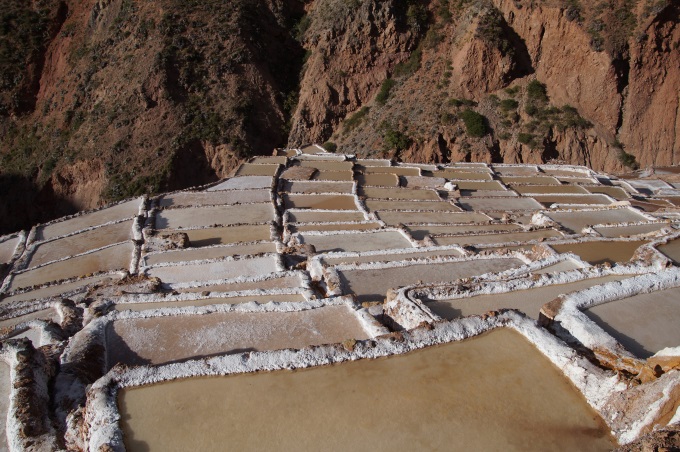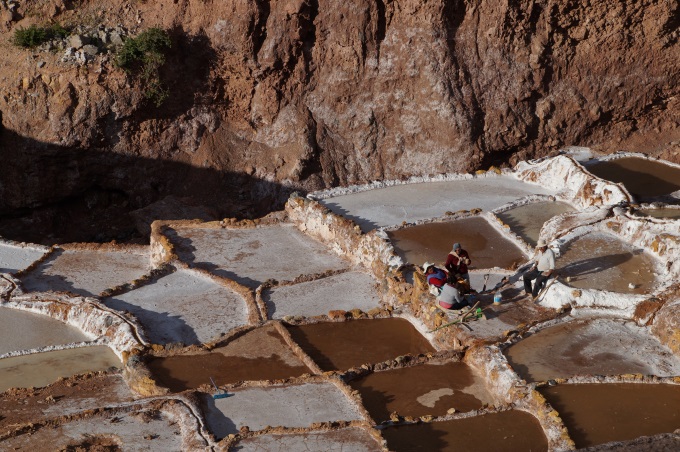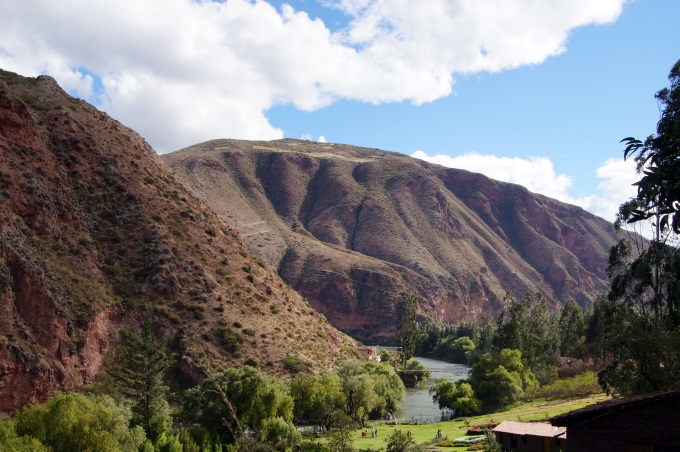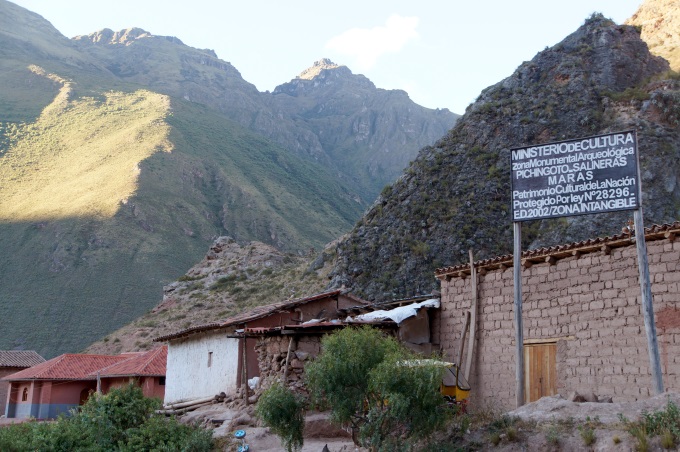A detailed report on the salt ponds of the Incas – still in use, beautiful beyond imagination and just a few hundred meters away from Maras.

Hidden deep within the Urubamba valley, lies – almost unknown to all the hordes visiting Machu Picchu every day – a precious gem: The Maras Salt mines, also called Maras salt evaporation ponds. A myriad of salt crusted terraces precariously nestles against the steep mountain sides, while a steady stream of mineral rich water trickles down with a silent gargling that somehow defies time.
The ponds, you ought to know, have been in use since the times of the Incas and before. They are one of the best day trips from Cusco – and they are quite different from all the other tourist attractions. They are also among the top 10 Inca ruins in Peru!
______________
Not far away and just as beautiful. Read about the Inca fortress Ollantaytambo here.

An underground spring, feeding on the waters from the lofty mountain range surrounding the sacred valley, carries along heavy silts and salt. Who can say if it was chance or ingenious will that created the first ponds, but one thousand years later the ponds are still being harvested by the natives for their salty wealth.

Access to the Maras salt ponds is by no means easy. Only travellers adventurous enough to climb deep into the branching crevasses of the Urubamba valley will be rewarded with the jaw-dropping view on the glittering pool. Perhaps that is one of the reasons the Salineras are still in use after all this time – no perfunctory tourist venue arrived to disturb the tranquil beauty.

Yet the Maras Salt Mines are beyond amazing: Know then, that no modern technology is used to harvest the pink salt of Maras. Walking along the crusted ridges of the ponds one does indeed believe that this how the Incas supplied their capital, Cusco, with salts.
_________
Wondering what else to do in Peru? Read my full Peru luxury itinerary!
Wondering what to pack for Peru? Check out my detailed Peru packing list
The Maras Salt Mines explained

But how exactly does this ingenious system work? Over countless generations, the terraces of the Maras Salt Mines have been meticulously built with hands, shovels and uncounted strong arms. Each pond measures roughly 4 to 10 square meters, with a depth of around 10 to 30 centimetres – position, the layout of the land and altitude seem to be governing their size.

Impressive wooden batons are used to flatten the ground of each pond. Presumably to create ideal conditions for the crystallization process. The pressure of the beating surely also helps to create a tight surface that will withstand the heavy soaking.

Mind you – this is no light work! The locals invited me to try it myself and I more or less failed miserably. After my 10th attempt or so I managed my first successful hit – trying to lift a 5-kilogram baton with one hand and then hitting the sand flat is not easy, be assured!

After the salt ponds are prepared, water is let in through a tight network of channels that crisscross the terraces. You will find quite similar networks in all Inca ruins. These just happen to be still in use. So how cool is that?

The salt ponds of Maras really are not that sophisticated if you take a closer look. There aren’t any special inlets or outlets worth noting. The water is sometimes actually being shovelled in with buckets and whatever else is at hand. Mostly the little rivulets running down the terraces are just diverted by means of a simple minor trench in the wall of the pond.

Either way then starts the evaporation process. The intense Andean sun leads to a rapid concentration of the salt solution, while repeatedly fresh mineral water may be added. The pink salt falls out as soon as the mineral rich solution is oversaturated – forming pretty little salt flowers on the surface and more crystals in the murky brown brine beyond.

Workers then harvest the salt with sieves and shovels – pilling up little salt pyramids and draining the pond in the process. This is extremely taxing work that even visually takes its toll on the people. Callused hands, bent backs, and parched faces are the reward of a life-long servitude in the Salineras. Even though a guide informed me that the Maras Salt Mines are a cooperative – without an owner and a just system to govern the use of the terraces. Actually, you can even buy the Maras salts on Amazon: here is the link.

I for one am happy enough that I am just a visitor. Yet the people there seem happy. And who could fault them? Their income seems safe enough and the scenery around them is, to say the least, beyond beautiful. I was even invited to some maize-beer. Be prepared to be asked for a few Soles in return for the favour of taking a picture (a habit that seems to be common around Peru as a whole). It somewhat undermines their easily offered hospitality. Personally speaking, I have to say: As long as the experience remains authentic, I can spare a few coppers – even though the pink Maras Salt sells for a premium.
A word of scientific warning. I have read reports (and Wikipedia for that matter) stating that each pond would be exactly 30 centimetres deep. Others claiming that a complex drainage system regulates the in- and outflows of each pond, or philosophizing on the uniform measurement of the ponds. I found little to no evidence of any such sophistication. At the end of the day, they are just random artificial ponds that make use of the available space along the steep mountainside, a mineral-rich spring and the intense Andean sun. It doesn’t make the Maras salt ponds less beautiful, but I really do not see the need for mystification.
How to get to the Maras Salt Mines, Peru

Having read all that you are probably wondering how to get there, right? There are two ways to reach the Maras Salt Mines. Despite their name, they are actually located not that close to the little community of Maras. Instead, you will find them somewhere in between the town of Urubamba and Maras. You can either hike (or drive) down from Maras or make your way up from the Urubamba River.

Since I stayed at the Belmond hotel (which happens to be located 500 meters away from the entry) I chose the latter option – knowing that I wouldn’t enjoy the bird’s eye view on the Salineras the Maras approach offers. The trail from Urubamba starts with a lovely bridge over the river just a few meters away from the main road, leading through the scenic Sacred Valley of the Incas.

From here a well-used dirt road leads further on to the small community of Kachi (which means “salt” in the local tongue”). Not much of interest can be seen here. However, you are required to pay a small fee of 10 soles to enter the valley beyond where the salt mines are located.

This is where the ascent to the salt mines will start. You won’t be seeing them yet. In fact, the valley around you looks uninhabited and forlorn (which is pretty much close to the truth). Without the less than official looking ticket booth, I would have been quite sure to be in the wrong place.

But I implore you – do go on! The hike up to the Maras Salt Mines will be quite strenuous and takes about 30 minutes for those in good shape and already accustomed to the high altitude. It is by no means hard or overly treacherous. Yet, of course, the altitude of roughly 3.000 meters will take its toll on you. So don’t forget your sunscreen, don’t forget to bring along a bottle of water, and some might even welcome walking sticks to bear some of the weight to the top. At any rate, solid outdoor shoes will be needed. With a bit of patience and some endurance, the hike should be manageable for everyone – there’s no need to rush, rather take your time and enjoy the serene beauty of the Sacred Valley.

Despite that solitude it is almost impossible to get lost – just keep on the path following the little mountain stream further upwards (in the case of doubt keep to the left). After roughly 30 minutes you will finally turn around a last bend in the serpentine path and get your first view on the salt mines. From here they will look, please forgive me the comparison, a little bit like a rock covered with guano. Yet what initially looks like bird shit will shortly bloom into a breath-taking vista of reflecting ponds – each step taking you close to the reflecting mirage.

The easiest way to explore the salt ponds is by sticking to the official path that leads along the upper ridge. If you are a little more surefooted you should definitely take the chance and walk right into the salt pond fields as well. Don’t be afraid – there is a system of well-worn tracks on the sturdier ridges of the ponds that you will find fairly easy to navigate. This will give you the chance to get in contact with the locals and observe the harvesting in the Maras Salt Mines from a better vantage point.

The salt mines stretch for quite a bit and actually continue onwards over the first hill. Right at the top of the Maras Salt Mines, you will find a little shop where you can buy the freshly harvested salts and enjoy a cup of coffee. It is a somewhat touristy thing but do go there anyway since it will give you a good view of the whole salt pond system.

From the souvenir shop, it is only a couple of meters further upwards to the road leading to Maras. In fact, a lot of tourist operations will drop their visitors out here. Personally, I found little use in booking a tour to the salt mines. Chatting with the locals will give you a way more intimate experience (at no cost) and the hike up to the Maras Salt Mines is its own rewards. Only if you are very short on time this might be an option – but then again driving up the winded dirt road up to Maras will actually take just as much time as hiking up from the main road of the Urubamba valley.

A taxi or one of the many motor taxis (how the TucTucs are called in Peru) will drop you out from Ollantaytambo or Urubamba for a few soles. That is pretty much all you need. On your way back you will find it equally easy to halt a taxi that will take you back. The main road of the Urubamba valley is highly frequented by buses, taxis and other means of transport – so do not be afraid. (Like I said, I stayed at the Belmond Hotel on the outskirts of the town of Urubamba. So there was no need for any transportation.)

Bonus for choosing the hike: If you got keen eyes you will be able to see some old tombs on the left side on your way up (quite at the start into the valley of the salt ponds). Once mummies must have been left there for their final rest, but have been raided long ago. To be fair they are nothing all too special – yet they will convey a sense of age other tourists might miss. The Maras Salt Mines are, after all, a place of history and not only breathtakingly beautiful.
Summary of the Maras Salt Mines in Peru
Uniqueness: 5
Price: 1
Accessibility: 3
Authenticity: 5
Beauty: 4
(Max = 5)
For me, the Maras Salt evaporation ponds are truly the most amazing Inca site in Peru. The sparkling pools really are special. Don’t just drive past them (as many tours starting from 40km away Cusco are wont to do), but do get inside. I hope this little article could convince you to do so!

Hope you liked my little report on the Maras Salt Mines. Would you go there, if you had the chance? Share your thoughts in the comment section below.









Oh wow..your pictures are amazing! thx for the share… never heard about it but you made me change my peru itinerary! Actually didn’t want to stop from my way from Cusco to Machu Picchu, but now i will! great!
Do you know if this site is open year round? I’m visiting in rainy season (November)
Hey Janice,
as far as I know, it is. But I am not sure if they are producing salt during these months.
Been there……..nicely described……well done.
Steve
Thank you so much. I am going early august and will surely use this article as a guide.
Can you swim in them ?
Hey Diana,
no, you can’t. First of all, the salt mines here is meant for the food industry, so it would be hm..not what the customers would be expecting.
But more to the point – the water is not all that warm (remember we are almost 3.000 meters high) and very shallow. Only 10-15 centimeters.
Would be a very cool thing if you could, tho!
Thanks so much for sharing really really useful
Great post! So informative!
Happy travels!
Anna
Fantastic article! Do you know if there is opportunity to do any type of homestay in the area?
Beautiful article and photography! I visited back in May 2018 and was completely awestruck by these Salineras! Love how you got to capture a different perspective of them. I went with a tour group from Cusco and only got to visit from the top of the mines. Enjoyed your article, going to link it in my blog post about the salt mines if thats ok.
Happy travels!
Sara,
Hey Sara,
yes Maras is a special place. And thank you for adding me as a resource to your lovely blog. much appreciated!
Loved this! And appreciate very much the info about the Salt Mines and also many other wonders in Peru. I am downloading your reports like crazy! When I blog about some of our Peru adventures, I will be sure to reference you.
My worry is that the mines might not be open for tourists in December….: (
Hey Mary,
glad you liked my guides. I would love to read your reports once you return!!
Well, December is quite the rainy season, so it’s not exactly the ideal for visiting the sacred valley or the maras salt mines. I am not sure they operate during that time – but obviously they will be there for the views.
Nice article! Mary, I was there with a friend in the first week of December, 2017. They were open and operating and no foreign people besides my friend (Chile) and myself (USA). The weather was sunny, but quite breezy and cool at the site. Was still a great day!! :)